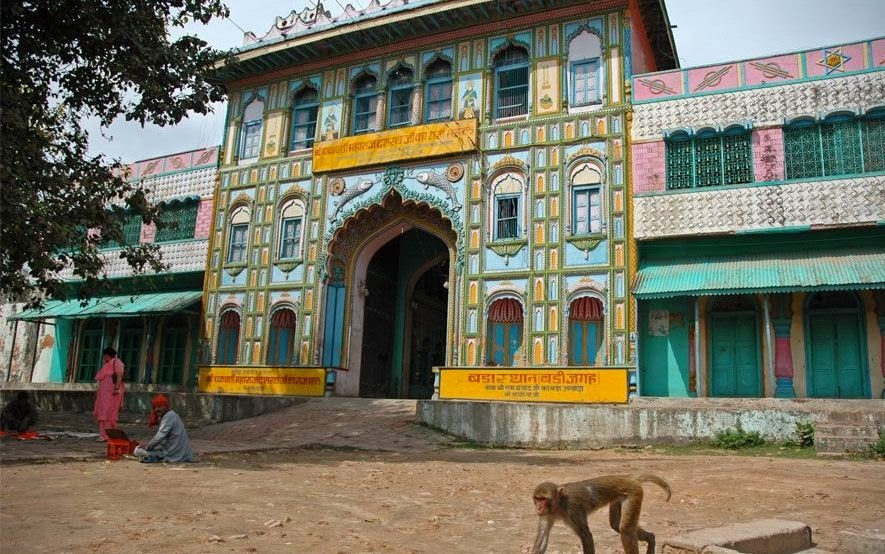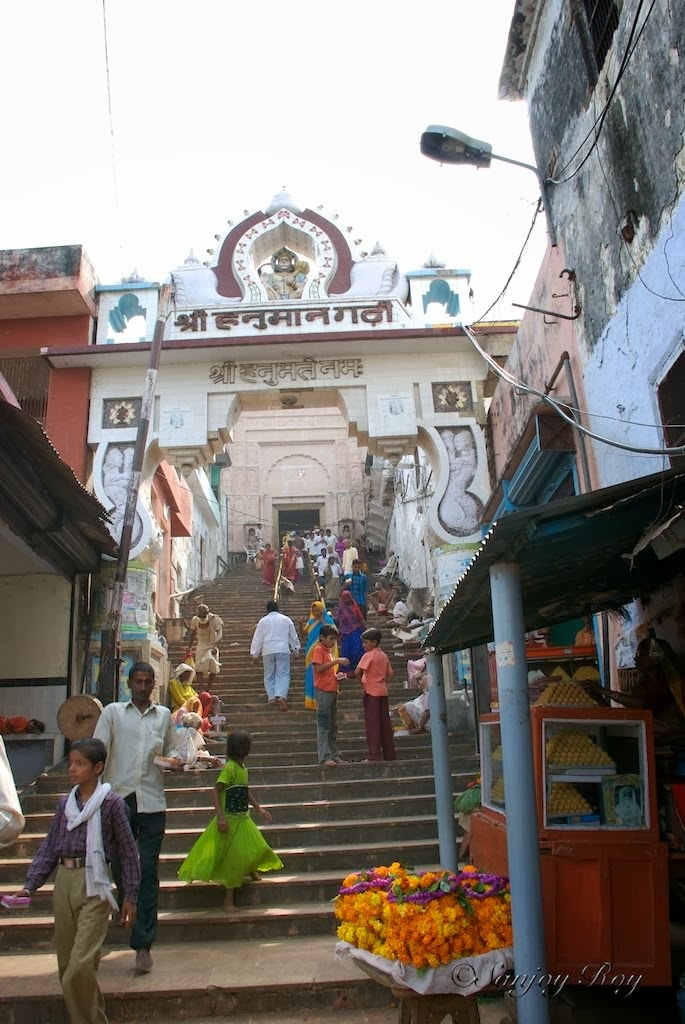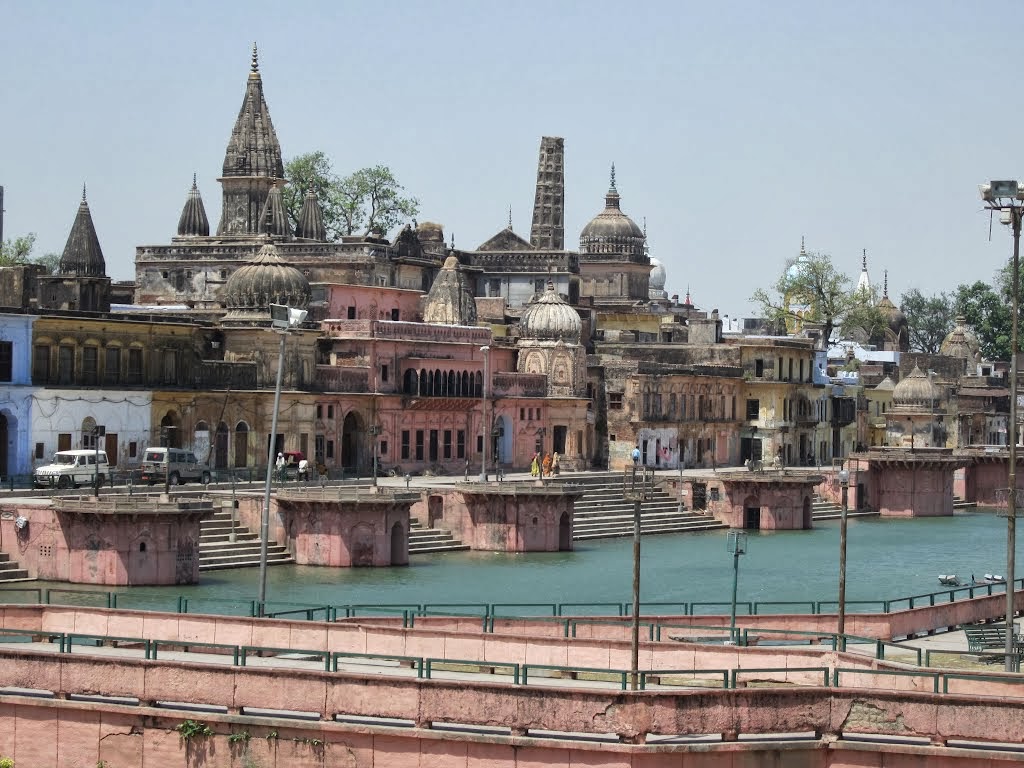Ayodhya Parikrama, Holy Places In And Around Ayodhya
vinashaya cha dushkritam.
Dharma sansthapanarthaya
sambhavami yuge yuge.
Meaning: For the up-liftment of the good and virtuous,
For the destruction of evil,
For the re-establishment of the natural law,
I will come, in every age
This sloka in the Gita 4:8, describes the purpose of Lord taking different avatharams (forms). For this purpose Lord has taken many forms, in these Lord Rama avatharam is of special importance. Lord Rama itself mean Satyam (True), Nermai (Honesty), Nidhanam (Patience), Karunai (Kind), Shanti (Peace). That is what comes to our mind, when we think about Lord Rama. Person with these qualities will be liked by everyone. Life becomes full of joy when one absorbs all theses qualities in them. It is great feeling, following the footsteps of Lord Rama. It will lead us to extreme happiness. In footsteps of Lord Rama meaning - the way He lived and the path He traveled from Ayodhya to Thirupullani. We can follow the footsteps of Lord Rama with respect to these three factors - geographically, culturally, philosophically.
Guptar Ghat:
It was from here that Lord Sri Rama ruled the earth for 11000 years and left for Vaikuntam from here. It is believed that Lord Rama left for heavenly abode at this place. There were no one in Ayodhya except the twin son's of Lord Rama - Lava & Kusa. Lava & Kusa were the one who rebuilt the Ayodhya City and brought it to greater glory and stardom. Another important tributary of Ayodhya is river Sarayu. The structure, which you see in the below image is Guptar Ghat.

When someone very close to our heart leaves us, we would feel very sad and depressed. But when Lord Rama left for Vaikuntam, everyone were in great joy because Lord Rama took everyone who were residing in Ayodhya to Vaikuntam along with him. This is very surprising, but Nammalvar confirms in the verse (Thiruvaaymozhi 7.5.1) as below...
purpaa muthalaap pullerum paathi onru inriye,
narpaal ayoththiyil vaazum charaacharam murravum,
narpaaluk uyththanan naanmukannaar perra naattule.
Meaning:Why would anyone want to learn anything but Rama?
Beginning with the low grass and the creeping ant with nothing whatever,
He took everything in the good city Ayodhya everything moving, everything still,
He took everything born of the lord of four faces, He took them all to the very best of states.
How kind is Lord Rama, He gave Vaikuntam to all the animate and inanimate things in Ayodhya. Hence everyone were happy on that day. We have seen the last adhyayam (chapter) of Lord Rama. From now on, we will be seeing all the places related to Lord Rama by travelling in his footsteps. All these places will help us in getting rid of our sins. With blessings of all great souls, we will start our journey in the footsteps of Lord Rama.
We have reached Ram Janma Bhoomi Ayodhya. Kulashekhara Alwar sings on Ayodhya as anganedu mathilpudaisoozh ayotthi yennum. Aparajitha (invincible), Ayodhya (unassailable) are the different names of Vaikuntam. The same name holds good for this city. The Kings of Ikshvaku Dynasty ruled the kingdom with Ayodhya as their capital. The activity of Circumbalating (Valam in Tamil) Ayodhya is considered as most pious activity. Now we all are going to do Ayodhya Parikrama (circumbalate).
Ayodhya Parikrama:
Parikrama or Pradakshina refers to circumambulation of sacred places in Hindu context. Parikrama means "the path surrounding something" in Sanskrit, and is also known as Pradakshina ("to the right"), representing circumambulation. Both words are mostly used in the context of religious deities in a temple, sacred rivers, sacred hills and a close cluster of temples, and "doing a parikrama" as a symbol of prayer is an integral part of Hindu worship. At times the outermost parikrama path covers the whole village/town/city, thereby implying that the length of the path can stretch. Circumbulation of important religious places is also an important religious ceremony being followed by the devotees as a regular practice. It involves paying homage to different deities in many temples that one covers in the Parikrama.
Parikramas followed in Ayodhya: Ayodhya is perhaps the most noted place in the northern India where parikramas are undertaken by Hindu Pilgrims. These are circumambulations of important religious places and are of varying duration, shortest being the"Antargrahi Parikrama" which has to be completed within a day. After taking a dip in the Sarayu, the devotee commences the parikrama from the Nageshwarnath temple and passes through Rama Ghat, Sita Kund, Maniparvata and Brahma Kund, finally ending at Kanak Bhawan. Then there is the "Panchkoshi Parikrama"circuit of 10 miles (a distance of 16 Kms), which touches Chakratirtha, Nayaghat, Ramghat, Saryubagh, Holkar-ka-pura, Dashrathkund, Jogiana, Ranopali, Jalpa Nala and Mahtabagh. The"Chaturdashkoshi Parikrama" constitutes a circular journey of 28 miles (a distance of 45 Kms) made once a year on the occasion of Akshay Navami, which is completed within 24 hours. On the way, the people pay homage to deities in the shrines which are situated on these route.

Many devotees cover the parikrama distance by offering Dandvat Pranam at each and every pace. "Danda-vat" a Sanskrit word, literally means lying on the floor like a stick. Devotees perform Dandavat Pranam by lying fully prostrate on the en route of the Parikrama with their arms stretched out. After getting up, they lie down again from the point of their forehead last touched the ground and perform Dandvat Pranam. This cycle of performing Dandavat Pranam continues till the end of the journey.
Right now, we are going to see all the places at Ayodhya in brief. In up coming article, we will be covering all the holy places and shrines in the route with their significance in detail.
Temples and Holy places in and around Ayodhya:
Kanaka Bhavan:

This is Lord Rama and Sita Matha's Palace (Anthapuram where public are not allowed). It houses the idols of Lord Sri Rama and Sita wearing gold crowns.
Dasrath's Palace:

This is palace of King Dashrath. It is said that throne of King Dasharatha was here. After marriage Lord Rama and Sita came here first and got down here from pallakku (well decorated palanquin).
Hanuman Gaddi:

A famous temple for Lord Hanuman is located on a hillock. There are about 76 steps to reach the main shrine.
Valmiki Bhavan:

In this bhavan, the complete 24000 Sanskrit verses of Valmiki Ramayana is inscribed on white marble placed at walls and portraits relating to Ram Katha are painted on the walls. Idols of Maharishi Valmiki along with his pupils Lava and Kusha, the twin sons of Lord Ram are seen here.
Lakshman Ghat:
It is said that Lord Rama's brother Lakshmanan left for Sri Vaikuntam (heavenly abode) from here.
Ammaji Mandir:

A beautiful small south Indian styled temple, right in the middle of Ayodhya.
Guptar Ghat:

It was from here that Lord Sri Rama ruled the earth for 11000 years and left for Vaikuntam from here. It is also known as Gopratar Theertham.
Sarayu River:

Sarayu river is also named as Netraja, Vaasishti, Ragabandha etc. for its purity.
Vasistha Kund Temple:
Vashishta was guru (teacher) and in this place he thought Lord Rama and Lakshmana. A staircase from here descends down to the Vashishta Kund.
Like above places, we have many other places in the Parikrama. If you happen to visit Ayodhya, see to that you cover all the places.

No comments:
Post a Comment